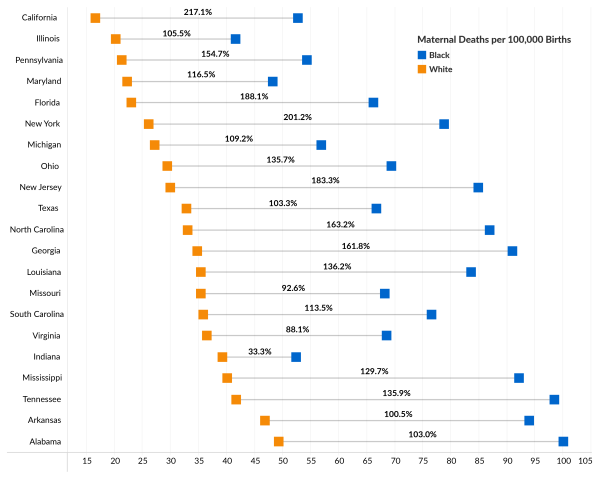
The United States has one of the worst maternal mortality ratios (MMRs)—the number of maternal deaths per 100,000 live births—of countries in the Organisation for Economic Co-operation and Development (OECD). Though part of this is due to the US having a different method of recording maternal death than other countries, according to the American Journal of Obstetrics and Gynecology, and the Centers for Disease Control and Prevention (CDC) there is clear evidence that the US has a high MMR that is continuing to deteriorate.
The US also has a considerable gap in maternal mortality between White and Black mothers, with Black mothers having a considerably higher mortality risk. This gap has been repeatedly documented in both national and site-specific data, according to the American Journal of Public Health and the Journal of Clinical and Translational Science. The Milken Institute’s 2023 Maternal Mortality among Vulnerable US Communities report documents the states in the US with the highest MMRs (which are predominantly in the southeastern US) as well as the Black-White gaps in those states.
The figure below shows the MMR for both Black and White mothers in each US state that had at least 20 maternal deaths for both populations in 2019. Data are drawn from the Underlying Cause of Death data from the National Center for Health Statistics (NCHS) and made available by the CDC.
US Maternal Mortality in 2019, Deaths per 100,000 Births by Race and State

Source: Authors’ analysis using NCHS Underlying Cause of Death, Single Race Files (2019)
There are two distinct but related features of note in the data. The first is seen in the raw MMR values (shown as squares): The levels are high. The rate of maternal death for any of the US populations plotted above is higher than the OECD average of 10.9 maternal deaths per 100,000 live births. Levels are higher in some states than in others: States in the southeastern US, for example, have some of the highest rates of maternal mortality for both Black and White mothers.
The second feature of the data is that there are large and widespread gaps in the MMR between Black and White populations. The rate of maternal death is higher for Black mothers than for White mothers in all the states shown. Still, there is considerable variation in the size of these gaps from state to state, and the states with the largest racial disparities in MMR are not the same states that have the highest levels of mortality in general.
While the southeastern US has some of the highest rates of maternal mortality, it is states such as New York and California that have the largest disparities, with statewide Black MMRs that are over three times larger than their statewide White MMRs. The disparity is still present (and sizable) elsewhere, but the states that have the worst overall maternal mortality have differences that are closer to doubling than tripling.
The United States does not have just one maternal mortality problem but two: high levels of maternal mortality in general and a demographic disparity in maternal mortality. The problems are linked: You cannot have a disparity without at least one group having poor outcomes, but the places that are hardest hit with high death rates are not the same places that have the largest inequities.
This is an important distinction. Some interventions may be better at closing gaps, and some interventions may be better at creating broad-based improvements in maternal survival, and they would optimally be targeted at different (but in some cases overlapping) places. The Milken Institute’s May 2024 report, A National Network to Advance Innovative Financing for Women’s Reproductive Health, explores ways to fund expansion of and access to women’s health services. This is one example of an intervention that would help decrease mortality overall and could potentially help shrink gaps to the extent that these expansions can target disadvantaged populations. It is part of a larger effort by Milken Institute Health to promote practical, innovative, and scalable solutions to address critical issues in women’s health.

























